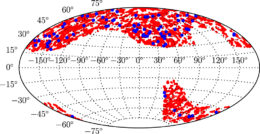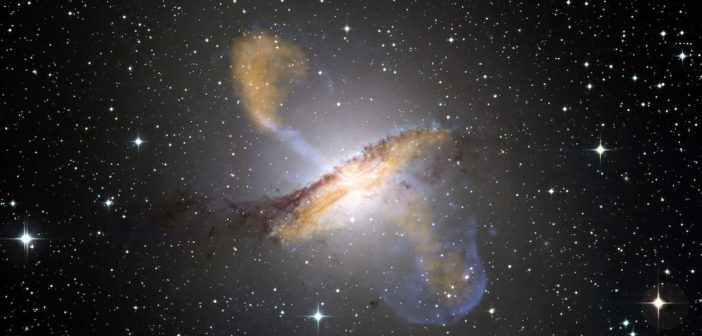What’s going on in our high-energy sky? Powerful phenomena abound in our universe, and they can produce photons with tremendous energies. A new study explores a high-energy mystery from one of these sources: active galactic nuclei, or AGN.

Gamma rays span a broad range of energies in the most energetic part of the electromagnetic spectrum. Very high-energy gamma rays initially emitted from AGN have energies above 100 GeV, but these are reprocessed by interactions with background photons to energies of 1–100 GeV. [Ulflund]
Where Are the Gamma Rays?
Active galactic nuclei — the accreting supermassive black holes lurking at the centers of some galaxies — dot our universal landscape, spewing out very high-energy gamma-ray photons within jets moving at nearly the speed of light. These energetic photons speed across the sky — but they don’t travel unencumbered.
Theory predicts that this energetic emission should be effectively reprocessed as it slams into the cosmic microwave background, generating a compact sheath of gamma-ray emission in the 1–100 GeV range, beamed forward in the direction of the jets emitted from each AGN. But there’s a problem: we don’t see this expected flux.

Galactic coordinates of the sources used to generate the authors’ stacked analysis. Two types of AGN-containing galaxies are included: FR I and FR II galaxies. [Broderick et al. 2019]
Stacks of Galaxies
Though the proposed gamma-ray halos may be too faint to spot individually, Broderick and collaborators suggest that by stacking a bunch of gamma-ray observations of off-axis AGN on top of one another, we should easily be able to detect their combined halo — if it exists.

The process of aligning the jets in two different radio images: an FR I galaxy (top) and an FR II galaxy (bottom). [Broderick et al. 2019]
Broderick and collaborators then stack these observations and compare their results to a model of what we would expect to see if an intergalactic magnetic field were deflecting the gamma-ray photons, generating a faint halo around the AGN.
Still No Halos

Top: the authors’ stacked gamma-ray observations for FR I (left) and FR II (right) galaxies. Bottom: the expected signals if gamma-ray halos were present. The observations clearly rule out the presence of faint halos. [Broderick et al. 2019]
What does this mean? Broderick and collaborators argue that this requires us to consider brand new physics in high-energy processes. There must be some unexpected mechanism that prevents the creation of the expected gamma-ray halos, either because the highest-energy emission is suppressed in gamma-ray bright AGN, or because some process affects this emission before it can lead to the generation of halos. The mystery deepens!
Citation
“Missing Gamma-Ray Halos and the Need for New Physics in the Gamma-Ray Sky,” Avery E. Broderick et al 2018 ApJ 868 87. doi:10.3847/1538-4357/aae5f2
